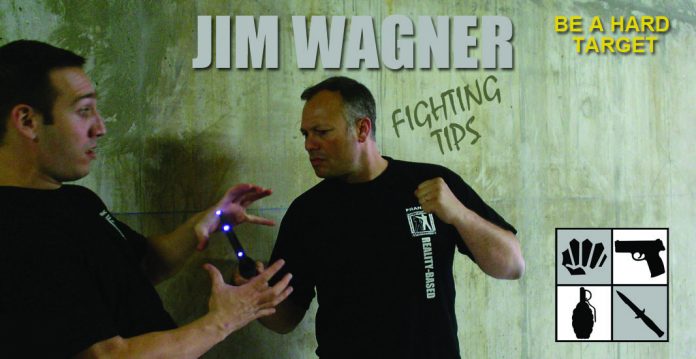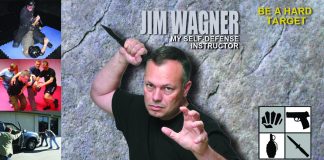This article discusses Jim Wagner’s 10 Rules of Combat based on his observations of the key elements to surviving actual hand-to-hand combat.
My uncle once told me, “It is easier to be a doctor than a car mechanic. Doctors only have two different models to repair, but a mechanic has to know how to repair hundreds of models.” This observation is humorous if you’re a mechanic, but we all know that a human being is infinitely more complex than the most sophisticated vehicle. Although the typical human has only one head, two arms, two legs and a torso, it’s the human brain, which directs the body to work in order to accomplish a wide variety of tasks. One possible task is to engage in conflict with other human beings.
Regardless of the complexities of the brain, with all of its multi-layered motivations and creativity to wage battle, the average human is still limited to what work (techniques) can be performed while fighting since we are limited physically by one head, two arms, ect. Because we are limited physically, there will always be similarities in hand-to-hand combat, regardless of what part of the planet you live on. In other words, there are “universal truths” in real combat, just as there are universal truths with vehicles; a vehicle functions no differently in Africa as one does in Asia.
As a former soldier, and a police officer of 15 years, I have experienced my fair share of combat. My martial art skills have been put to the test on a number of occasions. Plus, a Defensive Tactics instructor from some of the most elite police and military teams of the world, I have trained with literally thousands of men and women who have “tasted” real combat. I have also been a devoted martial artist for 28 years from tradition, to sport competition, to reality-based, and everything between. Though these experiences I have discovered that those who have actually had to rely on their skills for survival tend to train the same, use similar techniques, and think the same (like-minded) regardless of their geographical location. What has resulted from my observations are 10 rules that I believe are the key elements to surviving an actual hand-to-hand combat.
These are Jim Wagner’s 10 Rules of Combat:
- Be in good physical condition. True warriors keep in shape. Just look at any Special Forces Unit or police SWAT team in the world and you will see this to be true. You must condition your body in all areas; cardiovascular, strength, and flexibility training. In addition to be able to endure prolonged fights and be more resistant to injuries, being physically fit will also increase your “command presence” (a police term which means that you gain respect by appearing as a formidable foe).
- Do not be devoted to any one particular fighting system or instructor. If you are serious about reality-based training, and all you want to know is how to defend yourself, then you must diversify. Study as many fighting systems, from as many qualified instructors as you can. For example: to be good a punching you might study boxing for six months, then move on. To know how to fight on the ground take six months of ju jitsu and move on. To become lethal with knives and other non-projectile weapons you need to enroll yourself in a Filipino Kali (also known as Arnis or Escrima). Six months later go take some Israeli Krav Maga for practical street fighting techniques. By exploiting the fundamental principles from each system, you will not ever fall into a trap of the “group think” mentality.
- Keep it simple. Without doubt, almost half of what you know can be eliminated. In real fights, when your safety is at risk, your mind and body will force you to use gross motor skills, whether you like it or not. This means that the complicated techniques you may be practicing will give way to primitive methods of survival. If you don’t believe me, go up to someone better you full contact. Thus, instead of wasting valuable training time practicing fany moves you will never use, become highly proficient at the few techniques that will actually work – low thrust kicks, elbow and knee strikes, eye goudging, hard-hitting closed-fist strikes, hair pulling, etc.
- Train hard to fight easy. In the American Military we have an expression, “The more you bleed in training, the less you bleed in battle.” You must always train harder than what you may face in real life.” The average street fight lasts for 15-30 seconds, therefore you must practice all out: for a full minute or more. Instead of bowing to your training partner and practicing your techniques, run 2.5 kilometers first, then try them (this simulates the exhaustion of the battle). Instead of sparring with one person, go up against two or three. Always push yourself to the point of near exhaustion when you train.
- Positive mental attitude. The true warrior is never defeated mentally. He or she has a grasp on what we call, the will to survive. In some people it is stronger than others. Likewise, there are cowards who would not fight if their life depended on it. The will to survive is developed by pushing your training to the limit mentally (through role playing and increasing your pain tolerance threshold) and physically (trusting in reality-based techniques). Of course, an actual combat experience that you may have reinforces the will to survive.
- Scenario training (role playing). It’s not enough to just know how to do fighting techniques, you must know in what context to use them. Most martial arts schools have their students bow to one another, get I into a prepatory stance, then begin fighting. But, this is not the way it happens in real life. There are sudden bar fights, terrorist attacks, arguments that erupt into fighting, and the list goes on. Therefore you have to approach at least1/3 of your training like you would as is preparing a theatre production: actors, a script, props, and a story line (the other thirds would be practicing various techniques and conditioning). In other words, you must simulate events you are most likely to encounter as a civilian: robberies, bar fights, sexual assaults, and other modern violence. Doing it right requires wearing the proper clothes, creating a temporary, but realistic environment, and have your actors behave in a convincing manner. Military and police units do this all the time. It’s about time that civilian schools follow.
- Practice from A to Z. Let me start with an example. If you are practicing knife defense you don’t just say “attack me!” then do your technique, and that’s all. There are certain events that lead up to a knife attack, and a chain of events even after the knife attack; this is of course part of your scenario homework to know what usually takes place. Practicing from A to Z means.a. Being aware of your surroundings before an attack
b. Have a plan of action prior to the attack
c. Handle the crisis (using the techniques that apply)
d. Follow-up (escape, take the suspect into custody, simulate calling the police, treating injuries, ect.) - Dress as you fight. Do you ever wear a business suit? Then practice fighting in one. Do you ever wear a heavy jacket in the winter? Learn how to punch and ground fight in one. Do you wear shoes or boots? Now you get the idea. The more you train in various “street clothes” the better prepared you will be in actual combat. For most of my courses that I teach, I make my military and police students wear everything they would wear in a real mission minus the live ammunition and other hazardous weapons.
- Adaptability. True warriors are flexible, and able to change tactics with the situation. Combat is fluid, so you can’t be burdened with wanting to throw your “favorite” techniques. One way to learn how to rapidly adapt is to have your training partner introduce a surprise without your knowledge. For example; you may be working on ground techniques, when suddenly your partner pulls out a concealed knife (rubber training knife) and you have to unexpectedly deal with it. Or, you could be fighting with one partner and half way through the fight another student comes into the room to help you like a Good Samaritan. How would you coordinate your attack?
- Aggressive Defense. Many people think self-defense means waiting for the attacker to throw the first punch. However, if you feel at anytime you, or someone else is in danger of immediate bodily injury or death, international law states that you have the right to defend yourself. (Check your own local laws to know your rights. Therefore, if you have to strike first, then do it. That’s why scenario training is important to understand the signs of imminent conflict. Also, during a fight you must think do as much damage as necessary, as fast as possible to overload the attackers senses and to stop him. Put him on the defensive with pre-empted attack or immediate counterattack. Adopt the military mentality, “attack the attacker.”
As I mentioned before, these rules are based on my own experiences, and those who have successfully survived real encounters. If you agree with my 10 rules, adopt them. If you don’t then write your own down and evaluate them. Every professional warrior has a written form of their rules of engagement, and every unit lives by a motto. You need to know yours before you “engage” the enemy. Deciding what you believe, and how you should act during a battle maybe a little too late.




